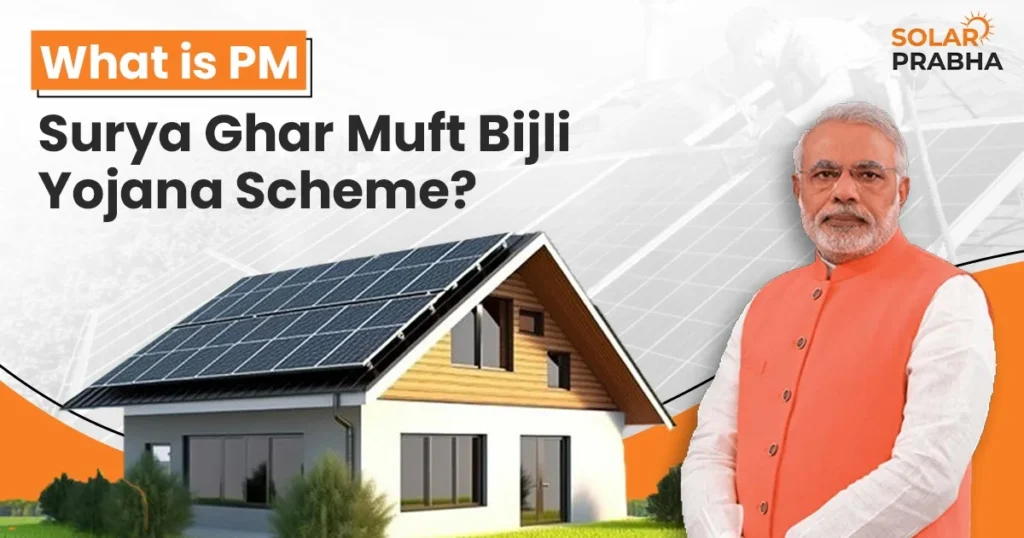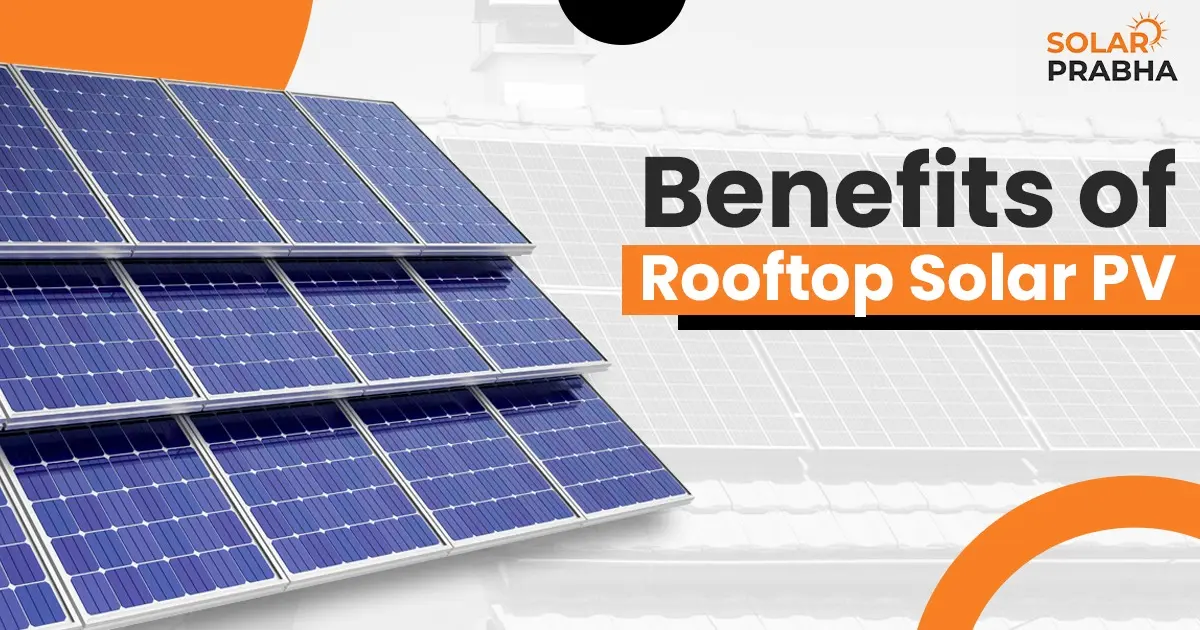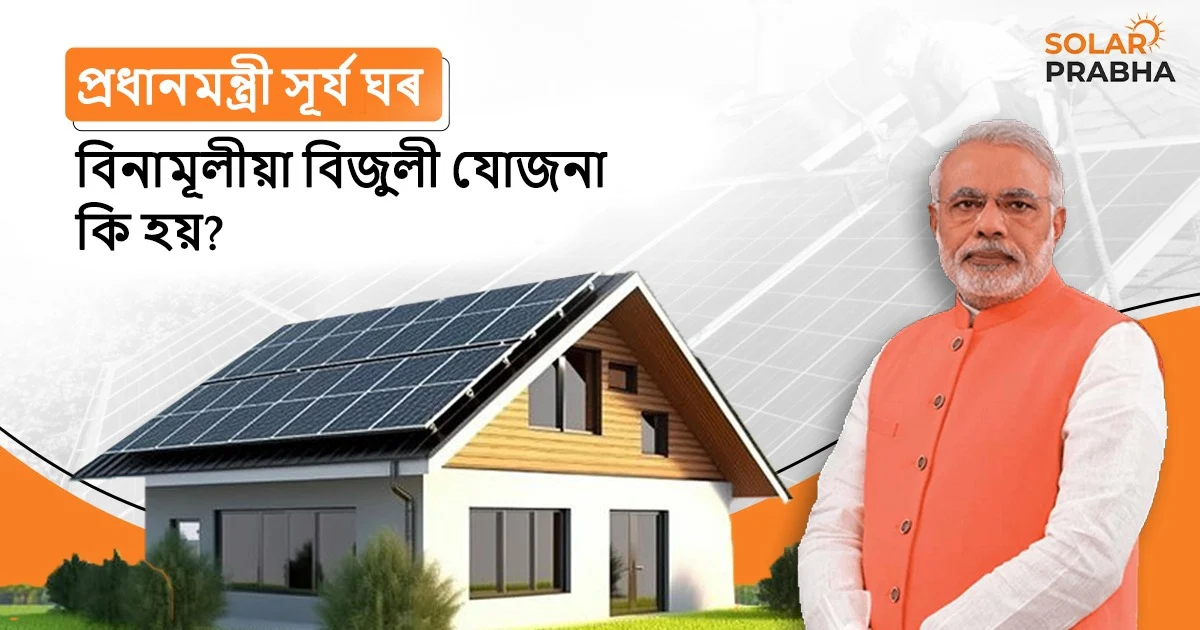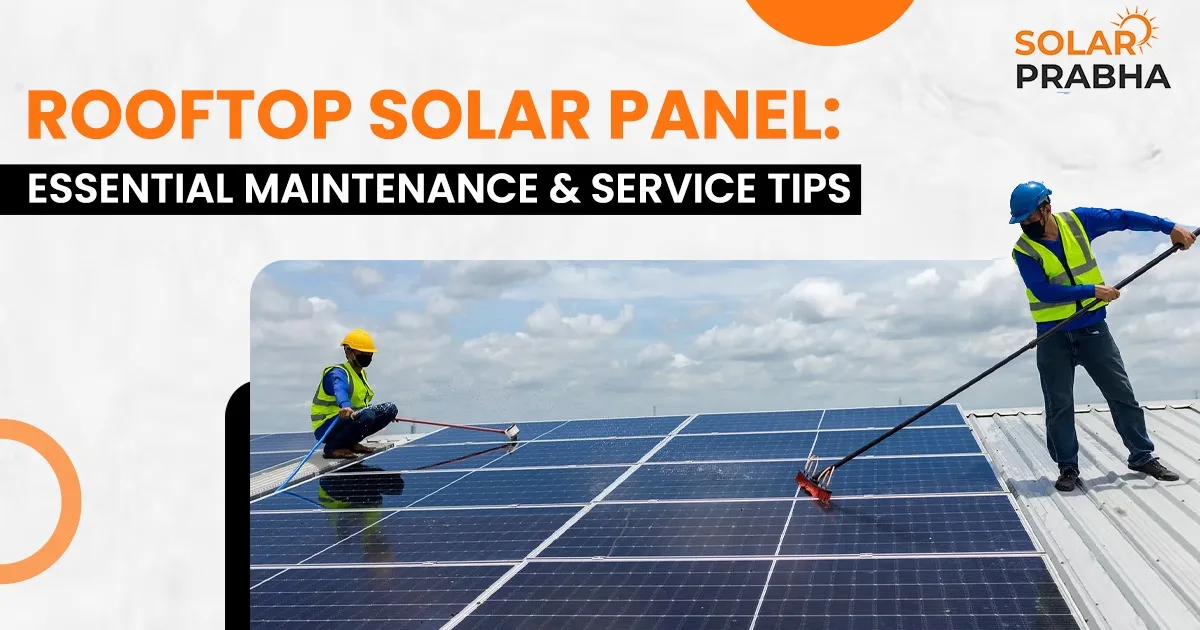Are you tired of skyrocketing electricity bills and constant power outages? The PM Surya Ghar Muft Bijli Yojana is here to revolutionise how you power your home. This groundbreaking scheme is set to illuminate households across India with free solar electricity, and we’re here to shed light on this game-changing initiative.
In a world grappling with climate change and the hazards of fossil fuels, sustainable energy solutions have never been more crucial. Solar energy, clean and renewable, has emerged as a beacon of hope. The Indian government, recognising this potential, has launched the visionary PM Surya Ghar Muft Bijli Yojana. But what exactly is this scheme, and how can it benefit you? Let’s dive in and explore the sunny side of energy independence.
In this comprehensive guide, you will get to know about the PM Surya Ghar Muft Bijli Yojana, from eligibility criteria, and benefits, to the installation process. Read along to learn how you can harness the power of the sun and light up your home for free!
Free Electricity for Millions: PM Surya Ghar Yojana
The Central Government scheme PM Surya Ghar Muft Bijli Yojana was approved by the Union Cabinet on February 29th, 2024 with an allocation of Rs.75,021 crore. Going further, it aims to provide free electricity to one crore Indian households by installing rooftop solar power systems. Consequently, eligible households stand to receive up to 300 units of free electricity per month.
PM-Surya Ghar: Muft Bijli Yojana, which has been approved by the Cabinet, is going to be a game changer for bringing sustainable energy solutions to every home. Harnessing solar power, this initiative promises to light up lives without burdening pockets, ensuring a brighter,… https://t.co/kSj0E40Ehf
— Narendra Modi (@narendramodi) February 29, 2024
PM Surya Ghar Muft Bijli Yojana: How It Operates
Anyone opting for this scheme will get a subsidy of 60% of the solar unit cost for systems up to 2 kW capacity. Also, 40 per cent of additional system costs are for systems with a capacity between 2 and 3 kW. However, the subsidy limit is at 3 kW capacity.
Therefore, currently, this will mean that for Assam and special category states for a 1kW system, the central subsidy is Rs 33000. The state subsidy is Rs 15000, so a total of Rs 48000’ Again for 2kW the central subsidy will be Rs 66000 and the state subsidy Rs 30,000 so, the total is Rs 96,000. Again for 3 kW capacity the central subsidy is 85,800 and the state subsidy is Rs 45,000, so the total is Rs 1,30,800.
PM Surya Ghar Scheme Key Points
The ambitious PM Surya Ghar Muft Bijli Yojana has set a goal to make India energy efficient and reliant on renewable energy sources for residential, commercial and industrial requirements. Four Key Points that you should know:
- Objective: The PM Surya Ghar Muft Bijli Yojana aims to achieve its target of making 1 crore households solar energy efficient with rooftop solar installations within a year. Further, it aims to fulfil the broader objective of attaining 40 GW of rooftop solar capacity by 2026.
- Nodal Agency Role: The Ministry of New and Renewable Energy (MNRE) has designated REC as the primary program implementation agency for the scheme.
- Key Public Enterprises: The NTPC, NHPC, and PowerGrid, are set to play a significant role in setting up rooftop solar systems. Also, they will perform under the RESCO model and get financial support from REC.
- Financial Growth: The REC has set ambitious plans to grow its renewable energy loans to Rs 300,000 crore by 2030. Moreover, it has a current sanctioned amount of about Rs 125,000 crore.
- Financial Assistance: Each household stands to get a central financial assistance (CFA) of up to ₹78,000 (around $1,000) to cover partial installation costs. However, the subsidy is subject to the capacity of the system, with higher capacities receiving greater support.
- Free Electricity Potential: The program has a target of providing up to 300 units of free electricity per month to beneficiary families. Consequently, the program will reduce their electricity bills and eliminate the need to pay bills totally.
- Job Creation: There is a potential for job creation once the scheme is on the road. Also, estimates indicate that the scheme will create around 17 lakh (1.7 million) direct jobs. Further, job avenues will come up across various sectors, including manufacturing, installation, and maintenance.
- Environmental Benefits: The scheme looks forward to reducing carbon dioxide emissions by 720 million tonnes by adding 30 GW of solar power generation capacity. However, it will be a gradual growth over the lifetime of the systems.
Benefits of PM Surya Ghar Muft Bijli Yojana:
The Pradhan Mantri Surya Ghar Muft Bijli Yojana offers a galore of benefits to the beneficiaries:
- Lower Electricity Bills: Beneficiary households will have lower or no electricity bills. Consequently, 15,000-18,000/- households will save up to 300 units of solar electricity.
- Energy Self-Sufficiency: The scheme will take forward the country’s aim of becoming self-reliant in energy production. Also, it will reduce dependency on external sources and the burden of electricity costs for the government.
- Economic Relief: Reduced electricity provides financial relief to families so that they can utilise their income for other pressing needs.
- Empowerment: By facilitating free energy, the scheme will help the underprivileged sections of society. Thus fostering a sense of self-sufficiency.
- Entrepreneurship opportunities: Unemployed youths stand to get work in the supply and installation of solar panels. Also, the technically skilled youth will have job opportunities in the installation, manufacturing, and maintenance of solar panels.
- Environmental Gains: The environment will be cleaner due to the use of renewable energy and also there will be less carbon emissions.
Challenges Ahead in PM Surya Ghar Yojana:
The PM Surya Ghar Yojana has some major hurdles in the years ahead:
- Implementation: The success of such a large-scale scheme will need an efficient plan for implementation and logistical hurdles. Moreover, it is not easy to cover a vast and diverse country like India.
- Loan Accessibility: It will be a marathon work to ensure easy access to credit for all eligible families.
- Rooftop Suitability: Houses in rural, small towns and also urban areas may not have suitable rooftops for solar panel installation. Therefore, this will be an additional aspect to be taken care of and provide alternative solutions.
Eligibility Criteria: Checklist
The eligibility for PM Surya Ghar Muft Bijli Yojana is given below
- All applicants must be Indian Citizens.
- Filing all documents that are required is mandatory
- Property ownership may be considered.
- Individuals who have not benefited from similar schemes will get priority.
- Individuals applying for the scheme must own a house with a roof suitable for installing solar panels.
- A valid electricity connection is mandatory.
How to apply for PM Surya Ghar Muft Bijli Yojana?
To apply for the benefits of the PM Surya Ghar scheme, the interested consumer has to register on the national portal www.pmsuryaghar.gov.in.
Here are the steps to register online:
- First, check out the Pradhan Mantri Surya Ghar Muft Bijli Yojana’s official website at https://pmsuryaghar.gov.in.
- Complete the steps to register by filling in your details such as name, address, and phone number.
- Click on the Upload tab to submit the necessary files and complete the registration process
- Note down the application ID for future reference.
List Of Documents Required for Registration:
Check out the mentioned documents below for applying for the PM Surya Ghar Muft Bijli Yojana and keep all documents ready for verification:
- Electricity bill
- Bank passbook
Application Process
Check out the steps here to understand how to apply for PM Surya Ghar Muft Bijli Yojana:
Step 1: First check out the official website of PM Surya Ghar Muft Bijli Yojana.
Step 2: Then click on the ‘Apply for Rooftop Solar’ button available on the left-hand side of the homepage.
Step 3: After that click ‘Registration’ and select the state, district, and electricity distribution company, enter your electric consumer number, and click on ‘Next’.
Step 4:Then type in your mobile number and email, and click on ‘Proceed’.
Step 5: Type in the required details on the ‘Apply for Rooftop Solar Installation’ form, upload the documents and click on the ‘Final Submission’ button to submit the form.
Step 6: Now wait for the feasibility approval from DISCOM. It should be noted that feasibility approval is waived off up to 10 kW. When it gets approved, install the plant through a registered vendor in your DISCOM.
Step 7: Now submit the plant details and apply for a net meter after the installation is over as a select vendor. Also, an agreement between the consumer and vendor has to be uploaded.
Step 8: You will get a commissioning certificate from the portal after the installation of the net meter and DISCOM inspection.
Step 9: When the commissioning report is available, submit your bank account details and a cancelled cheque by logging into the PM Surya Ghar Muft Bijli Yojana portal. Your subsidy will be credited to your bank account within 30 days.
PM Surya Ghar Muft Bijli Yojana Installation Subsidies
Here is a detailed view of subsidies under the PM Surya Ghar Muft Bijli Yojana Scheme, that the government will provide for installing solar panels:
- For up to 2 kW – Rs. 30,000 per kW
- For capacity up to 3 kW – Rs. 18,000 per kW additionally
- Total subsidy for systems larger than 3 kW – Maximum Rs. 78,000
The appropriate rooftop solar plant capacity for households is:
| Average monthly Electricity Consumption (units) | Suitable Rooftop Solar Plant Capacity | Subsidy |
| 0-150 | 1-2 kW | 48,000 |
| 150-300 | 2-3 kW | Rs 96,000 |
| >300 | Above 3 kW | Rs 1,30,800 |
Moreover, the subsidy for Group Housing Society (GHS)/ Resident Welfare Association (RWA) is as much as Rs. 18,000 per kW for common facilities, including EV charging up to 500kW capacity at Rs.3 per kW per house. Also, the upper limit includes individual rooftop plants installed by individual residents in the GHS or RWA.
Conclusion
The PM Surya Ghar Muft Bijli Yojana is more than just a government scheme; it’s a pathway to energy independence, environmental sustainability, and economic relief. By embracing solar power, you’re not just saving on electricity bills; you’re contributing to a cleaner, greener India.
At Solar Prabha, we’re committed to helping you make the most of this transformative PM Surya Ghar scheme. As a trusted wholesaler and EPC provider in the Northeast, we offer top-notch solar solutions tailored to your needs, whether you’re a homeowner or a business owner.
Ready to join the solar revolution and benefit from the PM Surya Ghar Muft Bijli Yojana? Don’t let this opportunity slip away. Contact Solar Prabha today at +91-7099030047 and let us guide you towards a brighter, solar-powered future. Together, we can harness the power of the sun and light up India, one rooftop at a time!
FREQUENTLY ASKED QUESTION (FAQ’s)
-
Is Roof Top Solar completely free?
No, it is not completely free, however, there is a very huge amount of subsidy provided by the Government of India. Additionally, there is a subsidy from the central and state governments after installation.
-
How much is the Central & State Government Subsidy?
Assam is a special category state hence central subsidy here is 10% higher than other states. Central Govt Subsidy ( for Assam): 1 KW - Rs 33000, 2KW - 66000, 3KW & Above - 85,800. Every State has an additional State Subsidy which is different from state to state. Assam State Govt Subsidy : 1KW- Rs 15000, 2KW - 30000, 3KW & Above - 45000. Central + Assam State : 1KW 48000, 2KW 96000, 3KW & above 130800
-
How many Units are generated in one month?
1 KW Solar Panel generates a minimum of 100 Units in 1 month
In summers, this can increase from 100 to 130 units per month 2KW, 3KW and above will increase proportionally. -
Will I get batteries also in this package?
No. This is an On-Grid system that does not require any battery storage system. If you produce solar energy more than you consume it will automatically go to the APDCL grid. If you produce less than demand then the APDCL grid will directly provide extra electricity. There is no need and use for storage.
-
Will the Solar System work during a power cut from APDCL?
No. The Solar System will shut down during the APDCL power outage. This is done keeping the safety of linemen and other people and systems in consideration. APDCL will cut the power during a power outage for the safety of the lineman working on the line. Also, if the Solar System provides power to the grid then the lineman safety is compromised.
-
How will I get paid for the extra electrical units I supply to APDCL?
Units supplied by the consumer to APDCL will be deducted from units supplied by APDCL to the consumer. This will be carried forward to the subsequent months if the unit supplied by the consumer to GRID is more than the unit supplied by GRID to the consumer.
-
What type of Panel do you supply?
We supply bifacial mono perc half-cut PV panels. This is the latest technology which has more efficiency. These are Made in India panels in adherence to Government of India policies.
-
What is the warranty of the system and service?
The warranty of the system is for 5 years. If there is any fault in the system consumer can contact the vendor. Consequently, the Vendor will rectify the defect up to 5 years from the date of installation.
-
What is the difference between System Warranty & Product Warranty?
System Warranty of 5 years is mandatory as per government rules. If any component of the Solar System or wiring or supply of electricity is affected then the vendor has to rectify the connection or defective product for up to 5 years. However, a product warranty is available only for the product as per product manufacturer warranty norms.
-
How much is the product warranty?
Product Warranty on the Panel is 10 years for the Product and 27 years for linear performance. The product warranty on Inverter is 8 years. (Product warranty means that after the System Warranty of 5 years if there is any manufacturing defect in the product then the consumer can approach the manufacturer for its repair).
-
What is not covered under the Warranty Period?
Any defect that occurs due to a manufacturing defect is covered under warranty. However, any defects arising due to reasons such as thunderstorms, extremely high voltage supply, floor, normal wear and tear, rat bites, physical damage, or electrical damages are not covered under warranty. For more details please refer to the Warranty Manuals of manufacturers and government guidelines on subsidy.





